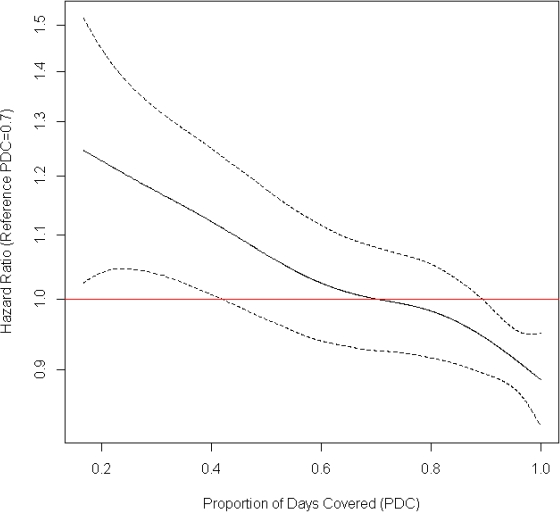Association of Tacrolimus Adherence and Discontinuation with Sepsis Risk among Kidney Transplant Recipients
J. Donnelly,1 P. MacLennan,1 R. Mannon,1 R. Saran,2 J. Baddley,1 H. Wang,3 G. McGwin, Jr.,1 P. Muntner.1
1University of Alabama at Birmingham, Birmingham, AL
2University of Michigan, Ann Arbor, MI
3University of Texas Health Science Center, Houston, TX.
Meeting: 2018 American Transplant Congress
Abstract number: A192
Keywords: Bacterial infection, Immunosuppression, Kidney transplantation, Risk factors
Session Information
Session Name: Poster Session A: Kidney Transplant Goes Viral
Session Type: Poster Session
Date: Saturday, June 2, 2018
Session Time: 5:30pm-7:30pm
 Presentation Time: 5:30pm-7:30pm
Presentation Time: 5:30pm-7:30pm
Location: Hall 4EF
OBJECTIVE: The association between post-transplant tacrolimus exposure and sepsis risk is currently unknown. We examined the associations of tacrolimus adherence and discontinuation with sepsis risk among kidney transplant recipients (KTRs).
METHODS: We conducted a retrospective cohort study using data from the United States Renal Data System. The study population included adult primary KTRs transplanted between 2004 and 2013 with one year of graft survival. We defined adherence based on pharmacy claims using the proportion of days covered (PDC), which is the proportion of non-hospitalized days for which tacrolimus was available. PDC<0.7 was classified as low adherence. Recipients who were without medication for at least 90 days were considered to have discontinued. Sepsis events were identified based on discharge diagnoses. We modeled time to sepsis using Cox models and reported hazard ratios (HRs) with 95% confidence intervals (CIs). PDCs over 6 months to 1-year post-transplant were modeled using smoothing splines. Low adherence and discontinuation were also modeled as time-varying exposures over 6 months to 3 years post-transplant.
RESULTS: A total of 26,577 KTRs were included and there were 2,392 sepsis events over 2.5 years of follow-up. The median 180-day PDC was 0.84 (25th-75th percentile 0.65-0.98) and over a third of KTRs had low adherence (33.4%). After adjustment for recipient factors, 180-day PDCs were associated with higher sepsis risk. When examined as time-varying exposures over 2.5 years of follow-up, HRs for sepsis were 1.10 (CI 0.99-1.22) and 1.54 (CI 1.35-1.75) for low adherence and discontinuation, respectively.
When examined as time-varying exposures over 2.5 years of follow-up, HRs for sepsis were 1.10 (CI 0.99-1.22) and 1.54 (CI 1.35-1.75) for low adherence and discontinuation, respectively.
CONCLUSIONS: Low tacrolimus adherence was weakly associated with sepsis when accounting for discontinuation and changes in adherence over time. However, discontinuation was associated with a 1.5-fold increased risk of sepsis. KTRs discontinuing tacrolimus should be monitored carefully for severe infectious complications.
CITATION INFORMATION: Donnelly J., MacLennan P., Mannon R., Saran R., Baddley J., Wang H., McGwin, Jr. G., Muntner P. Association of Tacrolimus Adherence and Discontinuation with Sepsis Risk among Kidney Transplant Recipients Am J Transplant. 2017;17 (suppl 3).
To cite this abstract in AMA style:
Donnelly J, MacLennan P, Mannon R, Saran R, Baddley J, Wang H, McGwin G, Muntner P. Association of Tacrolimus Adherence and Discontinuation with Sepsis Risk among Kidney Transplant Recipients [abstract]. https://atcmeetingabstracts.com/abstract/association-of-tacrolimus-adherence-and-discontinuation-with-sepsis-risk-among-kidney-transplant-recipients/. Accessed January 6, 2026.« Back to 2018 American Transplant Congress
